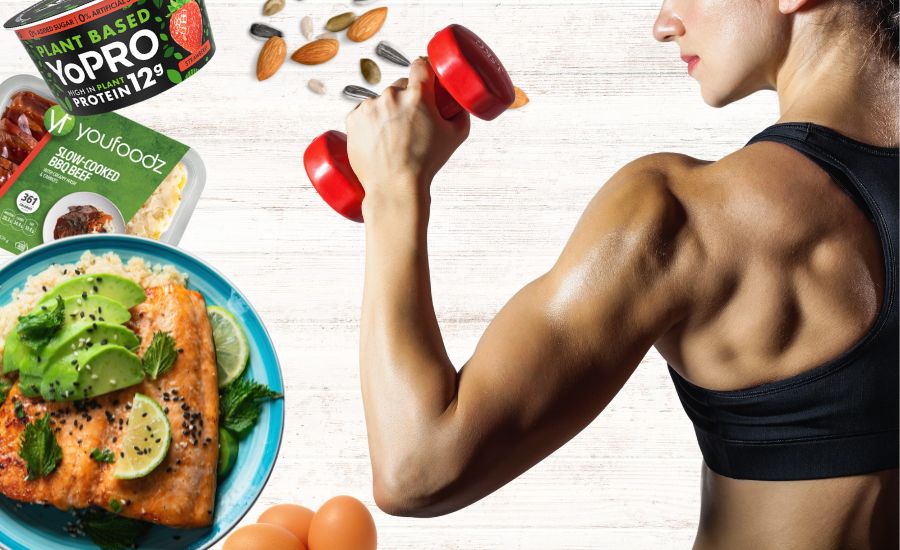How much protein does woman need to build muscle, especially if she is trying to lose fat at the same time.
Are you just burning fat or muscle as well?
If you are a woman on a mission to build muscles, especially if you’re also trying to lose some body fat, it is very important to consider how much protein does woman need to build muscle and maintain muscle mass during the fat-loss process. The hard truth is that unfortunately when we lose weight it can also be muscle if we are not careful with our calorie deficit. Meaning that just because the weight is going down on the scales, it doesn’t mean it’s only fat. If you spend prolonged periods of time in a strict deficit, (there is not a hard number as to what it is in terms of calories, because everybody is different), you could be at risk of losing the precious muscle mass you might be working so hard to build.
How can muscle mass be lost in calorie a deficit – personal example.
Just to give you an idea, for me personally I know that anything beyond 8 weeks of strict deficit, below 1500 calories per day, can mean that my muscles can also start shrinking despite regular weight lifting 4 times per week. How do I know this? I have had many body fat scans done during my bodybuilding competition years to see exactly what my muscle mass and body fat is doing when the diet changes. I have also had many of my clients go through the same process so I am speaking from experience observing my female muscle-building enthusiasts in the past 12 years of my role as a coach. When I was in a 20 week pre-competition shred I lost around 500g of muscle mass from dieting, even though I was lifting weights 6 times per week consistently as part of my prep program.
How to prevent muscle loss during a diet.
However, there is a way to reduce the likelihood of muscle loss during a shred phase and this can be done with the help of protein, many studies have shown that protein helps preserve as much muscle as possible while the body fat percentage is going down. This is what we call body re-composition. Muscle mass increases, and fat decreases so we start looking tighter, more shredded, and athletic which is the most desirable outcome for many women and men these days, if we were to just focus on aesthetics of course.
YOUR MUSCLE BUILDING DIET
Let’s look at your current diet, are you focusing on the right thing?
Clients I come to know through my work as a personal trainer don’t get enough protein in their diet in order to optimise their goals of building toned muscles. Some of them are aware of it, but just having a hard time figuring out how to get enough protein due to their busy schedule with kids, work and other responsibilities. And others are actually not aware that their protein intake is inadequate to optimise muscle building and get the most of their weight lifting efforts.
How much protein do you need for your weight?
For an active individual who is lifting weights to build muscles at least 2-3 times per week, it is recommended to have 1.5-2g of protein per kilogram of bodyweight. So for a 60kg woman around 90-120g of protein per day would be optimal. That is in macros, not in weight of the protein source.
For example; 100g of uncooked chicken breast contains around 34g of protein, 2 eggs will give you around 13g of protein, a lean 100g of red meat will normally have around 30g of protein. Just so you understand that even a food that contains mostly protein source is still not all protein, the remaining weight comes from water and possible other macro nutrients like fat.
What if you are low-carb?
If you are also trying to cut down the cabs in attempt to reduce your calories I would aim for the higher end of the recommended amount. So 2g per kg of bodyweight. When I work with my clients who want to lose fat while building muscles I encourage them to try their best and aim towards 110-120g of protein. But only if they are not obese or overweight, if they are, we will wait until they drop some weight and then increase their protein intake as their overall calories will increase also.
In the image below you can find approximate recommendation of how much protein woman needs to build muscle or if she is sedentary or just focusing on fat loss alone. Bear in mind that these are approximate recommendation and you should always consult with you doctor to check if you are in a healthy BMI range for your height or if you need to consider any other health factors or conditions. For some 65kgs is considered a healthy weight and for others it may mean they are overweight for their height. It will also depend on how much muscle mass you have, a more muscular individual will be more likely to have a healthy BMI at 65kgs in comparison to someone who isn’t.

For someone with a high BMI (overweight or even obese), notice that the protein will not be as high as fat loss will still be a priority for them even if they are working on muscle tone as well. The focus is on reducing calories while having enough protein for healthy function and recovery.

Can you have too much protein;
Yes, you can. For a healthy woman who is lifting weights regularly, there is no need to go above 2g of protein per kg of body weight, so a 60kg woman would benefit from around 100-120g of protein per day, preferably spread out throughout the day according to Harvard Medical School.
Too much protein can have a negative effect on your kidneys and cause health issues, most women I came across don’t need to worry because they don’t reach even close to that amount from experience. At least not on a regular basis.
To give you an idea of how you get more protein in a day, here is a break down how I do it for myself and my clients.
Breakfast; aiming for close to 30g of protein
Eggs, egg whites, turkey slices, ham, cheese, and protein powder in a form of a breakfast smoothie or added to oatmeal. Or some of the weeks I prepare a batch of my famous roasted capsicum fetta egg muffins that are loaded with protein and are low in calories, see the recipe. Some of my clients replaced capsicum with pumpkin and it worked a treat.
Lunch; aiming for close to 35g of protein
Tuna or roasted chicken with high protein pasta like Vetta Pasta, and some added frozen veggies, or a glute free option available at Woolworths or Coles if you are in Australia like Pulse Chick pea or Lentil range.
High protein wraps like Simson’s Pantry from Woolworths or Coles with turkey breast slices or ham with salad and avocado, and some times I would go for a healthy meal delivery service option if I am short on time and pre-order online.
Dinner; aiming for close to 35g of protein
I normally like to eat dinner with my family and as tricky as it can be with all of us having different tastes, I always opt for more protein and veggies and a little less carbs on my plate whether it would be spag bol, grilled steak or seafood or a chicken caserolle type of dish. I do find having a few meals from a healthy meal delivery service in my fridge helps as well at dinner, especially on those nights when my family want’s something that doens’t fit my goals at the time.
Snacks; any additional protein 10-15g if you are struggling to meet the minimum daily needs
If you do decide to have snacks always try to think “protein”, yes even at snack time, it can all add up. Things like high protein Greek yoghurt or cottage cheese, chia seed pudding preferably with additon of protein powder or high protein milk/plant milk, tuna or turkey slices on corn thins or rice cakes with avocado. Protein bars or protein shake.
By the way if you are stuck for ideas on how to get more protein into your diet and keep the calories low, I have a free Calorie Deficit Cheat Sheet, you can grab it right here or just enter your name and email below and Ill send it to you right away.
I hope my short blog article has give you a bit of clarity and you can now work out your protein macros with a bit more confidence. Don’t forget you can always reach out to me directly and I will be happy to guide you in the right direction. I am based in Sydney, but have online coaching clients from all over the world that I write programs for and do weekly check in’s via video to make sure they stay on track.













